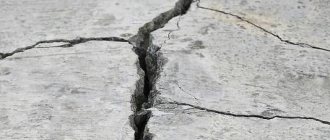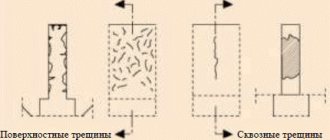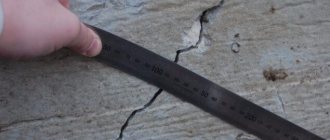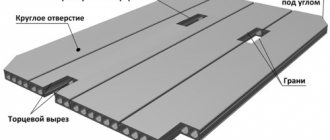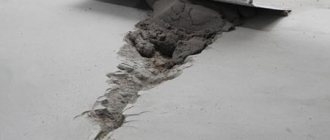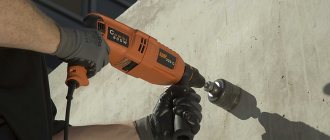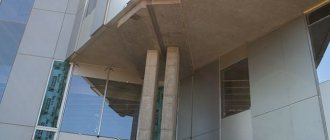Any crack that appears in a concrete or reinforced concrete structure has a negative effect on the performance of load-bearing functions.
Deformations in a concrete product have a negative impact on the entire structure, so their occurrence must be prevented.
Another significant nuisance that is caused by the appearance of cracks (for example, in the floor) can be the entry of moisture and various salts into the room. This scenario is possible due to temperature changes. Repair is a simple procedure, but requires certain knowledge.
In addition to the above, there are many different reasons that contribute to the formation of cracks in concrete. Regardless of which of them caused the appearance, repairs must be carried out immediately.
If treating a crack in concrete on your own is difficult for you, then the best option would be to seek help from professionals. Regular preventive inspection of concrete structures, filling cracks with special compounds and other necessary actions will save you from the need to carry out larger-scale repairs.
Reasons for appearance
Let us highlight the main reasons why concrete cracks when drying:
- Shrinkage. This type of crack is formed due to the incorrect composition of the mixture components or improper care of the fresh concrete surface after pouring, or exposure to direct sunlight;
- Temperature changes during the day. The difference can be 15 °C or more. Cracks appear when concreting a coating longer than 100 m. To eliminate this, expansion joints are installed in the concrete;
- Draft. A dangerous phenomenon for foundations and walls. Occurs when there is uneven load on the structure or an insufficiently strong foundation. It causes internal stresses in concrete and the formation of inclined cracking, while the strength of the structure decreases;
- Soil heaving. Occurs when the soil freezes in the winter and thaws in the spring. Cracking can be eliminated when the depth of the foundation base is below the soil freezing layer;
- Improper reinforcement of concrete structures. Violation of the location of the reinforcement, non-compliance with the thickness of the protective layer of concrete. This causes deformation and corrosion of the metal, and the formation of defects.
To prevent the occurrence of cracks on the concrete surface after pouring, the following measures should be taken:
- Ensure minimal shrinkage of the mixture during hardening;
- Do not allow poured concrete to dry out quickly;
- Avoid temperature changes during hardening;
- Eliminate mechanical and chemical factors.
To protect freshly laid concrete from unpleasant influences, it is covered with a tarpaulin or film. This will protect the mixture from solar heating and provide shelter from rain and snow. It is important to monitor the condition of the formwork to prevent leakage of uncured mortar. When the air temperature is above 5°C, it is necessary to water the concrete surface every 8 hours. Use deep vibrators when laying thick concrete layers.
Shrinkage of mature concrete
Shrinkage of mature concrete occurs after reaching the design age (28 days), during the period of operation. Lasts for three to four months after pouring. Subsequently it slows down extremely.
Previously, to ensure the strength of the entire building, the monolithic foundation was allowed to stand for a long time (up to a year) before loading. Now this is not necessary, since in modern low-rise housing construction, certain grades of cement and various special additives are used.
Shrinkage of mature concrete occurs due to:
- drying shrinkage (humidity shrinkage);
- carbonization shrinkage.
Carbonation shrinkage
Carbonation shrinkage is shrinkage as a result of chemical processes of interaction of hydration products with components penetrating from the external environment. This is due to the fact that all reinforced concrete is in a carbon dioxide environment.
Carbon dioxide, penetrating into the structure of concrete, interacting with water, forms so-called carbonic acid. Carbonic acid, in turn, interacts with calcium hydroxide, which is in the structure of cement stone, to form calcium carbonate and water.
The volume of the newly formed material is smaller than the original one. In addition, as calcium hydroxide disappears, the pH, an indicator of the basicity of the medium, decreases. And calcium hydrosilicates (the main part of cement stone) are very sensitive to this indicator: when the pH begins to decrease, they begin to recrystallize with the release of calcium hydroxide - in order to save the rest, sacrificing part of themselves. And this phenomenon also leads to a slight shrinkage of concrete.
The amount of carbonation shrinkage depends significantly on the size of the sample, the concentration of carbon dioxide in the air, the humidity of the concrete and the relative humidity of the air. In some cases, it can be equal in magnitude to moisture shrinkage.
Humidity shrinkage
Humidity shrinkage as concrete hardens and dries (drying shrinkage) is shrinkage as a result of physical and physicochemical processes that cause the removal of water (dehydration) from the concrete mixture during hardening and drying.
Humidity shrinkage during hardening and drying of concrete (physical-mechanical shrinkage) differs from plastic moisture shrinkage in that it is primarily hydraulic shrinkage, caused by the action of capillary forces that arise in the cement stone during the evaporation of water from the capillaries and the removal of intercrystalline water.
When free, physically unbound water located in large pores and macrocapillaries of concrete (with a radius greater than 0.1 μm) is removed, shrinkage deformations do not occur.
Humidity shrinkage occurs after the evaporation of free water, when capillary and structurally bound and adsorbed water begins to be removed from the concrete. The removal of capillary water located in small pores and microcapillaries with a radius of less than 0.1 μm causes capillary shrinkage, and the removal of physically bound water from new formations causes adsorption shrinkage.
Moisture shrinkage increases with increasing water content of the concrete mixture. Therefore, the less water in the concrete mixture, the less shrinkage there will be. Reducing the amount of water while maintaining the mobility of the concrete mixture through the use of superplasticizers is an effective way to reduce drying shrinkage.
Humidity drying shrinkage and carbonization shrinkage usually occur simultaneously and last for a long time.
Depending on the type of cement, the deformation of moisture shrinkage associated with drying is 5-10 times greater than the relative deformation of contraction shrinkage of cement stone.
Humidity shrinkage, which occurs as concrete dries, has the greatest effect on the behavior of concrete in structures.
Classification
Let's consider the classification of cracks that form in concrete after pouring:
- superficial hairline cracks in concrete;
- temperature-shrinkable;
- sedimentary cracks.
The latter are the most dangerous, appear as a result of uneven load on the structure and can cause the destruction of the entire building.
Concrete structures located outdoors are most susceptible to destruction. In addition to mechanical loads, their formation is caused by chemicals in the environment and the negative impact of climate.
Why do defects appear?
The causes of cracks are varied.
The most common ones include: Often, defects appear during the drying process of a reinforced concrete structure. As concrete dries, it loses its liquid and contracts. The process is difficult to control, especially when working outdoors.
The various reasons that result in defects are divided according to characteristic criteria. Cause:
- indicates the emergency condition of the structure;
- moisture penetration into reinforced concrete structures increases;
- wear and tear of a structure susceptible to corrosion;
- violations that cause concern.
The following types of formations damage reinforced concrete structures:
- through wedge-shaped;
- through-lap;
- non-through wedge-shaped;
- through parallel;
- inclined closed;
- longitudinal non-through.
Tolerances
The width of cracks in concrete is an important factor for determining the technical condition and load-bearing capacity of a structure. SNiP 52-01-2003 specifies tolerances for the width of cracks. We present their values for various conditions:
- In order to preserve the reinforcement in concrete, their width should not be more than 0.3 mm for prolonged opening, and 0.4 mm for short-term opening;
- Based on the requirements for concrete permeability. This value cannot be more than 0.2 mm for prolonged opening and 0.3 mm for short-term opening;
- For hydraulic structures, the value is taken to be 0.5 mm;
- The crack should not be 0.3 mm wide, provided that the structure is in an aggressive environment;
- Cracks with a width of 0.3 mm or more should not be allowed if the concrete structure is reinforced with metal elements with low corrosion resistance.
Farm Violations
Rafter trusses have the characteristic feature of working in compression, ensuring stability and rigidity of the coating. The connected elements contribute to the emergence of a concentration of stress of different types: tensile, compressive, tangential. High concentrations contribute to the occurrence of disturbances at the junction points. Tensile stress threatens a through vertical crack, while compressive stress threatens a non-through horizontal crack.
A number of reasons influencing deformation:
- low quality concrete;
- incorrect placement of transverse reinforcement;
- displacement of the metal frame.
Return to contents
Materials for sealing cracks
You can repair a cracked concrete floor with a mixture of cement and sand with the addition of styrene-butadiene latex. Small hairline cracks in concrete are covered with cement mortar. To eliminate wide and deep formations in structures, epoxy resins or sealants are used, and self-expanding tape and cord are used.
The cracks are reinforced with wire scraps. For concrete structures that are exposed to moisture, liquid glass would be suitable. It replaces epoxy resin in this age-old repair method.
Special compounds are used for repairs. The repair mixture for concrete includes cement-sand mortar, polymer additives made from alcohol and sulfanol. They can be replaced with PVA glue. Ready-made repair compounds are suitable - Reper, Lugato, Minuten Mortel, Constant Granito glue.
Rules of care
A set of measures aimed at achieving the grade strength of concrete and ensuring integrity consists of performing the following tasks:
- ensuring minimal shrinkage of the poured composition;
- preventing accelerated drying of the mixture;
- neutralization of temperature changes;
- prevention of mechanical stress and the influence of chemical reagents.
Compliance with these requirements will ensure an increased service life of concrete, which will have high strength.
When pouring concrete, remember to follow these recommendations:
Kawabanga! Expanded clay concrete blocks
When mixing the mixture, you need to follow the recipe and strictly observe the proportions between its components.
Methods
It depends on its size, origin and location, the purpose of the structure, and the place of formation.
Floor and wall repairs
First of all, the crack should be prepared. Use a brush to clean off dust and dirt and rinse with water. The surface must be dry before applying the solution. It is applied with a spatula, then the excess is removed, leveling the seam flush with the floor surface. Deep cracks are filled with epoxy resin or an expanding sealant is placed in them.
If a large hole has formed in the floor and the reinforcement is visible, you will have to perform more complex actions. After removing concrete fragments and dust, you need to treat the metal elements with an anti-corrosion compound. To increase the strength of the coating, pieces of wire are placed in the hole.
The entire surface of the hole is covered with a primer. Without waiting for it to dry, pour in the cement repair mixture. If a thick layer is necessary, apply in 2-3 steps, wetting each layer with water. When compacting, vibrating movements are performed to fill cavities.
The sealed surface is leveled with a spatula or trowel, giving it an even, smooth appearance. In the future, the coating can be sanded and coated with a finishing compound to hide the defect.
Wall repairs are carried out using the injection method. In this case, the binding solution is fed into the resulting cavity using a syringe. The mixture injected under pressure tightly fills the crack and forms a reliable bond.
Using sealant and self-expanding tape or string
To do this, you need to purchase a cord of the required thickness, a mounting gun, and sealant. Preparing the crack. Next we lay the cord. Fill the free space with sealant. Remove the excess with a spatula. We get a reliable connection that does not allow water to pass through.
The greatest popularity is inherent in the sealant ELASTOSIL, made in Russia, the French Rubberflex and the PLOW tape, also made by a domestic manufacturer.
Work execution technology
The choice of equipment depends on the materials that will be used for the job.
Filling voids in a concrete floor is carried out using: The choice of restoration technology depends on the characteristics of the damage. The set of equipment is selected based on the task at hand. For example, if a crack has formed in concrete, work is performed as follows:
When it is necessary to repair wet areas of the surface and perform waterproofing, work is carried out using a different technology:
Our services
- Repair of shrinkage joints
- Crack repair
- Concrete floor repair
- Concrete grinding
- Polishing concrete floor
- Sealing seams
- Filling voids
- Polymer floor covering
Order troubleshooting for free!
Defect testing is the process of detecting hidden and obvious defects in the floor covering, as well as finding out the cause of their formation. It helps you choose a floor repair technology, select the necessary materials and calculate an estimate for the work.
- Download presentation
- Download price list
Portfolio of completed works
Look at photos of our facilities in Russia before and after completion of work
Equipment used and its cost
If we talk about equipment for concrete injection, then the following are usually used for this purpose:
- Injection pumps. Their cost depends on the composition used. For example, a KSG-700 pump for cement mortars will cost about 82,000 rubles. For polyurethane and epoxy resins, the KSG 900 model, costing 48,000 rubles, is suitable. Also, you can find manual injection pumps on sale at a lower cost.
- Packers for injection. These elements are special tubes through which the solution is supplied to the concrete base. Now 1 injection packer costs about 50 rubles (however, it all depends on its size).
The cost of resin is about 800 rubles per 1 kg, acrylic gel will cost about 600 rubles. You will also need to buy protective tape, costing about 400 rubles per roll.
After purchasing everything you need, all that remains is to inject.

